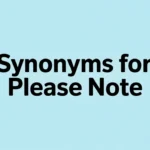Sometimes, when writing or speaking, we need to explain why something happens. Instead of always saying “this is because,” we can use different phrases to make our language more interesting and varied. Using synonyms and alternative expressions can improve clarity, enhance communication, and make your writing sound more natural. Other Ways to Say “This Is Because”.
There are many ways to express cause and effect in English. Whether you’re writing an essay, giving a presentation, or having a casual conversation, knowing different ways to say “this is because” can help you sound more fluent and professional. Some phrases work better in formal writing, while others are perfect for everyday speech.
In this article, we’ll explore several alternatives for “this is because.” Each section will introduce a unique way to explain a reason, ensuring you have plenty of options for different situations. By the end, you’ll have a stronger grasp of cause-and-effect expressions to improve your communication skills.
Due to This Reason
“Due to this reason” is a common way to replace “this is because.” It is often used in formal writing and presentations to explain why something happens. This phrase emphasizes the cause of an event or situation.
For example, in academic writing, you might say, “The experiment failed due to this reason: the equipment was faulty.” Here, the phrase highlights the direct cause of the failure. In casual conversation, you could use it like this: “She left early due to this reason—she wasn’t feeling well.”
While this phrase is useful, it is sometimes considered redundant because “due to” and “reason” both indicate causation. To keep your writing concise, you might replace it with simpler alternatives like “due to” or “for this reason.” However, in formal contexts, “due to this reason” still serves as a clear way to explain why something happened.
Read More: Other Ways to Say ‘Pleasure Doing Business With You’
As a Result
“As a result” is another effective way to replace “this is because.” This phrase clearly shows the connection between a cause and its effect. It is commonly used in essays, reports, and professional writing.
For example, you might write, “The road was icy. As a result, several accidents occurred.” This sentence structure makes it easy to understand that the accidents happened due to the icy conditions.
In spoken English, “as a result” also works well. If someone asks why you missed a meeting, you could say, “I was stuck in traffic. As a result, I arrived late.” This phrase adds a smooth transition between cause and effect, making your speech more fluent.
Overall, “as a result” is a great alternative to “this is because,” especially when you want to highlight the outcome of a situation in a formal or structured way.
For This Reason
“For this reason” is a direct and clear alternative to “this is because.” It works well in both formal and informal settings and is often used to emphasize a conclusion based on a given cause.
For example, in an essay, you might write, “The data was incomplete. For this reason, the results were unreliable.” This phrase helps connect cause and effect while maintaining a professional tone.
In casual conversations, you can use it naturally. If someone asks why you decided to change jobs, you could say, “The company didn’t offer opportunities for growth. For this reason, I looked for a new position.”
This phrase is particularly useful when making arguments or presenting logical conclusions. It helps strengthen explanations and ensures clarity in communication. By using “for this reason,” you provide a clear cause-and-effect relationship, making your statement more persuasive.
Because of This
“Because of this” is a simple yet effective replacement for “this is because.” It directly links a cause to its effect, making it a versatile phrase for various contexts.
For example, in an academic setting, you might write, “The policy was unclear. Because of this, many employees misunderstood their responsibilities.” This phrase helps establish a strong cause-and-effect relationship.
In everyday conversations, “because of this” works well, too. If a friend asks why you’re tired, you could say, “I stayed up late finishing my work. Because of this, I only got a few hours of sleep.” It keeps the explanation natural and easy to understand.
While “because of this” is slightly more informal than other alternatives, it remains a powerful way to express reasons clearly. It keeps sentences flowing smoothly while maintaining logical connections.
Owing to This
“Owing to this” is another formal alternative for “this is because.” It is often used in professional and academic writing to indicate a reason for something.
For example, a business report might state, “Sales declined significantly. Owing to this, the company revised its marketing strategy.” This phrase effectively explains the cause of an event in a professional manner.
In everyday speech, “owing to this” may sound a bit too formal. However, it can still be useful in certain discussions. If you’re explaining a decision, you might say, “The project faced multiple setbacks. Owing to this, we had to extend the deadline.”
This phrase works best in structured writing where a formal tone is required. It is a strong alternative for expressing cause and effect without sounding repetitive.
That’s Why
“That’s why” is a conversational alternative to “this is because.” It is commonly used in spoken English and informal writing.
For example, if someone asks why you missed an appointment, you could say, “I got stuck in traffic. That’s why I was late.” This phrase is simple and easy to understand.
In writing, “that’s why” can be used in blog posts, stories, or casual articles. A sentence like “The weather was terrible. That’s why we canceled the picnic” effectively communicates the reason in a natural way.
While “that’s why” is less formal than other alternatives, it is a great option for everyday conversations and informal writing. It keeps your language smooth and relatable while still making the cause-and-effect relationship clear.
This Occurred Due to
“This occurred due to” is a great way to express cause and effect in formal writing. It directly links an event to its cause and is commonly found in academic and professional documents.
For example, a research paper might say, “The machinery broke down. This occurred due to improper maintenance.” This phrase makes the cause-and-effect relationship clear while maintaining a professional tone.
In everyday conversation, it may sound a bit formal, but it can still be useful. If discussing an issue at work, you might say, “The delay occurred due to a scheduling conflict.” This phrase ensures that the reason is communicated effectively without sounding overly casual.
When using “this occurred due to,” it’s best to pair it with specific reasons to provide clarity and avoid vague statements. It is particularly useful when writing reports, essays, or official explanations.
The Reason Is That
“The reason is that” is a straightforward way to replace “this is because.” It clearly explains why something happened while keeping the statement easy to understand.
For example, in an academic setting, you might write, “The experiment failed. The reason is that the temperature was too high.” This phrase emphasizes the cause while maintaining clarity.
In daily conversation, it is also a useful alternative. If someone asks why you didn’t attend a meeting, you could say, “The reason is that I had another appointment at the same time.” It keeps the explanation direct and natural.
While “the reason is that” is a simple phrase, it works well in both formal and informal situations. It ensures that the cause is stated explicitly, making it an effective alternative to “this is because.”
Hence
“Hence” is a concise and sophisticated alternative to “this is because.” It is commonly used in academic writing and formal documents to establish a cause-and-effect relationship.
For example, a report might state, “The company suffered financial losses. Hence, budget cuts were necessary.” This phrase effectively connects the reason to the result while keeping the sentence concise.
In casual conversations, “hence” may sound a bit formal, but it can still be used in discussions. If explaining a choice, you could say, “I was feeling unwell; hence, I decided to rest.” It adds a touch of sophistication to everyday speech.
Since “hence” is a transition word, it is best used at the beginning of a sentence or between two clauses. It is an excellent choice for making writing sound polished and professional.
That Is Why
“That is why” is a natural and conversational way to explain a reason. It is commonly used in both spoken and written English to provide clarity.
For example, in a personal statement, you might write, “I have always been passionate about teaching. That is why I chose to become a professor.” This phrase helps emphasize the connection between passion and career choice.
In everyday speech, it works well too. If explaining why you were late, you could say, “Traffic was terrible. That is why I arrived late.” This keeps the explanation simple and easy to understand.
While “that is why” is more informal than some other alternatives, it is highly effective in making speech and writing feel natural. It is a great replacement for “this is because” in casual and professional settings alike.
Seeing That
“Seeing that” is a slightly informal yet effective alternative to “this is because.” It is commonly used in conversations to explain reasons in a natural way.
For example, if discussing a weather-related change of plans, you might say, “Seeing that it’s raining, we should reschedule the picnic.” This phrase helps establish a logical connection between the weather and the decision.
In formal writing, “seeing that” can also be used, but it is less common. A business report might include, “Seeing that customer demand has increased, we will expand production.” It provides a smooth transition between cause and effect.
This phrase works well in everyday discussions and informal writing. It makes explanations sound effortless while still clearly conveying the reason behind an action.
Given That
“Given that” is another strong alternative to “this is because.” It is often used to introduce a reason while maintaining a professional tone.
For example, in a research paper, you might write, “Given that the data was incomplete, the results were inconclusive.” This phrase helps frame the explanation in a logical and structured way.
In casual speech, it also works well. If explaining a decision, you could say, “Given that we’re short on time, let’s take a shortcut.” It makes the reasoning behind a choice clear and direct.
“Given that” is particularly useful in formal writing and discussions where logical reasoning is essential. It is a versatile phrase that enhances clarity and professionalism.
On Account of This
“On account of this” is a more formal way to explain a reason. It is commonly used in business reports and academic writing.
For example, a company might state, “The project was delayed. On account of this, we had to adjust the deadline.” This phrase effectively establishes a cause-and-effect relationship.
In spoken English, it may sound slightly formal, but it can still be used in discussions. If explaining a decision, you could say, “There were unexpected expenses. On account of this, we had to reduce our budget.”
While “on account of this” is a bit more structured than other alternatives, it is an excellent choice for professional and academic settings. It keeps explanations clear and authoritative.
By Reason of This
“By reason of this” is a formal way to replace “this is because.” It is commonly used in legal, business, and academic writing to explain a cause.
For example, in a contract, you might see: “The agreement was terminated by reason of this breach of terms.” This phrase makes the explanation sound official and structured.
In spoken English, it is rarely used in casual conversations, but it can be helpful in professional settings. For instance, if discussing a policy change at work, you could say, “By reason of this shift in company strategy, we are adjusting our goals.”
While formal, “by reason of this” provides a strong and authoritative tone, making it ideal for official documents and structured discussions. It ensures that the cause-and-effect relationship is communicated clearly and professionally.
Consequently
“Consequently” is a polished and professional way to express cause and effect. It is commonly used in essays, reports, and structured writing.
For example, in an academic paper, you might write, “The company failed to meet its financial goals. Consequently, it had to downsize.” This phrase clearly links the cause (financial failure) to its effect (downsizing).
In casual conversations, “consequently” may sound a bit formal, but it can still be used in structured discussions. If explaining why you missed an event, you might say, “I had a last-minute meeting. Consequently, I couldn’t attend the party.”
This phrase is best used in professional or academic settings where clear logical connections are needed. It adds a sophisticated tone while maintaining clarity in writing and speech.
Since
“Since” is a simple and effective way to replace “this is because.” It works well in both formal and informal writing and is widely used in everyday speech.
For example, in an essay, you might write, “Since the weather was bad, the event was postponed.” This phrase clearly indicates a cause-and-effect relationship while keeping the sentence concise.
In casual conversations, “since” is one of the most natural alternatives. If explaining why you were late, you could say, “Since my alarm didn’t go off, I overslept.” It keeps the explanation direct and easy to understand.
“Since” is a great alternative to “this is because” because it is simple, clear, and works in almost any situation. It is one of the most versatile options available.
As Such
“As such” is another useful phrase that can replace “this is because,” particularly in formal writing and discussions. It establishes a cause-and-effect relationship while maintaining a professional tone.
For example, in a business report, you might see: “The budget was reduced. As such, several projects were delayed.” This phrase smoothly connects the reason to the outcome in a clear and structured way.
In casual conversations, “as such” may sound slightly formal, but it can still be used. If explaining why a decision was made, you might say, “The restaurant was fully booked. As such, we had to find another place to eat.”
This phrase is particularly effective in formal writing and presentations where logical reasoning needs to be clearly outlined. It ensures that explanations sound polished and professional.
Seeing As
“Seeing as” is a casual and conversational way to replace “this is because.” It is commonly used in everyday speech and informal writing.
For example, if explaining why you’re making a decision, you might say, “Seeing as it’s late, we should probably head home.” This phrase helps keep explanations natural and effortless.
In more structured writing, “seeing as” can still be used, but it is best suited for informal content. A blog post might say, “Seeing as so many people enjoyed the event last year, we’ve decided to host it again.”
This phrase works well in friendly discussions and relaxed writing styles. It helps keep explanations smooth and conversational while maintaining clarity.
Owing to the Fact That
“Owing to the fact that” is a more formal alternative to “this is because.” It is often used in professional or academic writing when explaining reasons in detail.
For example, in an official report, you might read: “Owing to the fact that the market conditions changed, the company revised its strategy.” This phrase adds a strong sense of formality and structure.
In everyday speech, it may sound a bit too wordy, but it can still be used in professional discussions. If explaining a work-related decision, you might say, “Owing to the fact that resources were limited, we had to delay the project.”
This phrase is best used in formal writing where detailed explanations are necessary. It ensures that reasoning is communicated in a clear and authoritative manner.
That Being Said
“That being said” is a transition phrase that works as an alternative to “this is because.” It helps introduce a reason while also allowing for contrast or further explanation.
For example, in a discussion, you might say, “The policy was designed to be flexible. That being said, there are still some restrictions.” This phrase helps smoothly transition between statements while maintaining logical flow.
In casual speech, it works well too. If explaining a choice, you might say, “I love traveling. That being said, I also enjoy staying home sometimes.” It allows for a smooth shift in reasoning.
This phrase is particularly useful in structured discussions where you need to introduce a reason while also providing additional insight or contrast. It keeps explanations engaging and natural.
Conclusion
Expanding your vocabulary with different ways to say “this is because” can greatly improve your writing and speaking skills. Whether you need a formal phrase for professional writing or a casual alternative for everyday conversations, having multiple options ensures that your communication remains clear, engaging, and varied.
Phrases like “since,” “as such,” and “consequently” work well in structured writing, while casual alternatives like “seeing as” and “that being said” help keep conversations natural. Each of these alternatives adds variety and clarity to explanations, preventing repetition and improving the flow of ideas.
By incorporating these synonyms into your writing and speech, you can enhance your ability to express cause and effect in a more precise and engaging manner. Next time you need to explain a reason, try using one of these alternatives to make your statements more impactful.










